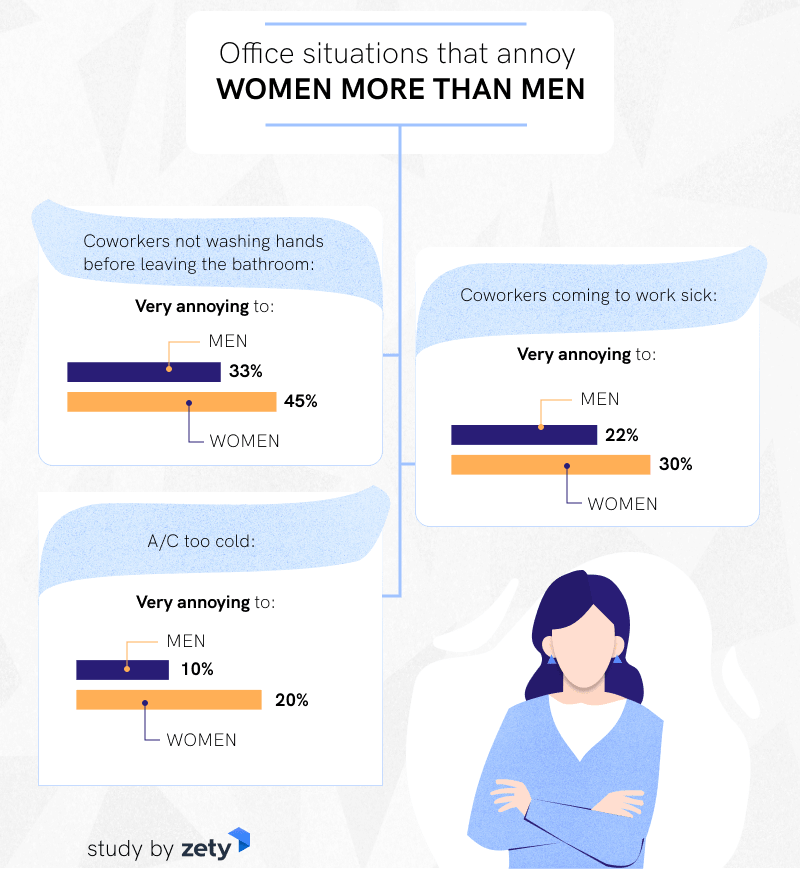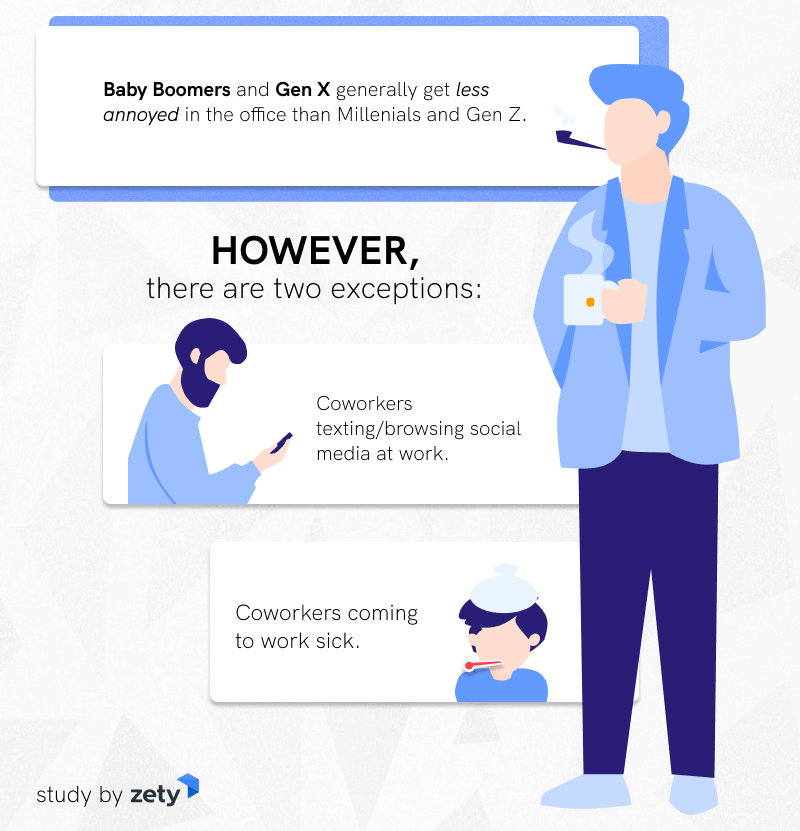
You open the office fridge. Grab your Tupperware... but someone ate half your casserole. You throw it in the microwave only to realize the interior looks like a scene of a crime. You want to grab a plate, but they’re all stacked dirty in the sink. You slowly lose your appetite and opt for coffee. But the coffee pot’s empty.
No matter how much we love our jobs, all offices come with people, habits, and situations that drive us nuts.
Inspired by hilariously “relatable” Tweets and stories about office pet peeves, we set out to find the worst ones.
We surveyed 1,026 Americans and asked them about:
- Everything that drives them mad at work.
- How annoying those situations are.
- How often they happen.
We can proudly say we’ve scientifically identified The Worst Office Offenders.
Gripes of Wrath
Before we did the actual study, we turned to Twitter, read dozens of articles about what steams Americans up in their offices, and asked our peers about their pet peeves.
First, we curated a list of 120+ office situations that grind gears.
Then, we narrowed those down to include only 28: the ones that just seemed way worse than others.
Before we tell you which one turned out to be the most horrendous, here’s a shortlist we came up with. In no particular order.
(From your personal experience—which of those make you fume?)
- Not enough coffee left in the pot
- Coworkers coming to work sick
- Coworkers coming in late or leaving early
- Printer out of paper, jammed or broken
- Coworkers chatting with each other or on the phone in a shared room
- A/C too cold
- A/C too hot
- Slow Wi-Fi
- No clean dishes to use
- People using your mug
- Not enough interaction with colleagues
- Coworkers not washing hands before leaving the bathroom
- Elevator out of service
- Coworkers’ bad breath or body odor
- Coworkers texting/browsing social media during work hours
- Not enough sockets available
- Coworkers’ chewing on pens/pencils
- Malfunctioning hardware or slow computer
- Conversations about politics or religion
- Not enough parking space
- People calling or arranging meetings to discuss things that “could have been an email”
- Coworkers or clients following up too soon
- People using too much cologne or perfume
- Too many meetings
- People using too much jargon and buzzwords
- Company firewall
- Depressing decor or bad lighting
- Being involved in conversations in a bathroom
For each example of an annoying office situation, we asked our respondents just two questions:
- How often they feel it happens
- and how angry it makes them.
We then came up with a tilt factor: we multiplied perceived annoyance level with reported frequency. Our assumption was that for something to really take the joy out of our work lives it has to happen fairly often AND be nothing short of infuriating.
Here it is. A list of America’s proud top 10 worst office offenders.
The worst office pet peeves in the US


So—
What can we learn from the list above?
Most definitely, we can divide the worst office pet peeves into four main categories:
- Ignoring health and hygiene rules: people coming to work sick and people not washing their hands before leaving the bathroom.
- Others’ not working hard enough: people coming in late or leaving early, chatting in the shared room during office hours or spending too much time browsing social media.
- Insufficient office tools and equipment: malfunctioning computers, broken printers, slow Wi-Fi.
- Workflow inefficiencies: meetings that happen too often and concern things that “could have been an email.”
And it makes perfect sense, doesn’t it? Ultimately, what annoys us most are the things that make it hard to keep up a good level of our own work.
We’re unlikely to perform well if:
- We catch someone else’s infection.
- Others fail to deliver their work.
- Technology lets us down.
- Our time gets wasted.
Also, let’s pause for a second to discuss *the* worst entry from our list.
Coworkers coming to work sick.
Can we please all take a vow to never, ever do it?
If you come in sick, you’re spreading your germs amongst:
- Your teammates.
- Members of other teams.
- Finally, all of their respective families.
Eventually, the snowball effect kicks in and everyone’s work performance and personal life suffer.
Feeling sick? Take a day off. Can’t do it? Work from home. Really. Simple as this.
Alright—
So you’ve seen the list of the most annoying AND common office pet peeves.
But—
Let’s see what happens if we remove the frequency factor.
Here’s a list of America’s most annoying office situations regardless of how often they happen (see new entries in RED).
The most annoying office situations
- Malfunctioning hardware or slow computer: 61% find it annoying or very annoying.
- Coworkers not washing hands before leaving the bathroom: 59% find it annoying or very annoying.
- Coworkers coming to work sick: 53% find it annoying or very annoying.
- Slow Wi-Fi: 51% find it annoying or very annoying.
- Coworkers’ bad breath or body odor: 50% find it annoying or very annoying (but only 28% feel it happens often or very often).
- Printer out of paper, jammed or broken: 48% find it annoying or very annoying.
- People calling or arranging meetings to discuss things that “could have been an email:” 46% find it annoying or very annoying.
- People using your mug: 45% find it annoying or very annoying (only 17% feel it happens often or very often).
- Coworkers coming in late or leaving early: 44% find it annoying or very annoying.
- Not enough parking space: 43% find it annoying or very annoying (only 31% feel it happens often or very often).
What do the three new items on the list tell us?
In short, while situations like not having enough parking space, other people smelling bad, or coworkers using your personal items all get on our nerves, luckily, they don’t happen too often.
Who gets annoyed by what? Office pet peeves across genders and generations
Men get more annoyed than women
We found no major differences in what gets on men and women’s nerves across US offices. But—
There’s one clear trend. Men reported higher levels of annoyance for 25 out of 28 office pet peeves we analyzed.
The only outliers?
- Coworkers not washing hands before leaving the bathroom: very annoying to 45% of women vs. 33% of men.
- Coworkers coming to work sick: very annoying to 30% of women vs. 22% of men.
- A/C too cold: very annoying to 20% of women vs. only 10% of men.

Why’s that?
Most likely, because women are more concerned than men about their health and overall office hygiene.
Gen Z and Millennials are angrier than Gen X and Baby Boomers
The general trend we found is: the older you are, the less angry you get.
Gen Z and Millennials reported higher annoyance levels than Gen X and Baby Boomers for a staggering 26 out of 28 office pet peeves in question.
Apart from these two:
- Coworkers coming to work sick: very annoying to 32% of Baby Boomers, 30% of Gen X, 24% of Millennials, 23% of Gen Z.
- Coworkers texting/browsing social media at work: very annoying to 25% of Baby Boomers, 15% of Gen X, 13% of Millennials, 11% of Gen Z.

It seems that younger generations are so used to the omnipresent social media that they barely notice their coworkers rummaging through their smartphones every day.
Also, surprise, surprise, older generations seem more concerned about their health and well-being (YOLO, right?).
Office situations we’re (surprisingly?) okay with
Now that you know what Americans are most annoyed by, let’s see what “pet peeves” aren’t as bad as they seem.
Here’s a list of the 10 least irritating office situations asked about in our study.
- Not enough interaction with colleagues: 19% of respondents find it annoying or very annoying.
- Coworkers chewing on pens/pencils: 25% find it annoying or very annoying.
- Company firewall: 25% find it annoying or very annoying.
- Not enough sockets available: 25% find it annoying or very annoying.
- Not enough coffee in the pot: 27% find it annoying or very annoying.
- Depressing decor or bad lighting: 28% find it annoying or very annoying.
- People using too much jargon and buzzwords: 28% find it annoying or very annoying.
- Being involved in conversations in a bathroom: 28% find it annoying or very annoying.
- No clean dishes to use: 29% find it annoying or very annoying.
- Elevator out of service: 29% find it annoying or very annoying.
Open-ended question responses (have we forgotten something?)
At the end of our survey, we included one open-ended question: just in case we forgot to include something really important on our list.
And—
It seems like we did.
Most answers to our additional “what else annoys you” question, concerned three issues.
(See some sample answers below.)
1. Office politics
2. Noise
3. Others not doing their job
And finally… Some bonus answers we loved!
Some specific-yet-relatable ones:
- “People discussing lunch plans at 9 AM.”
- “I’m sick of hearing about your children.”
- “Some employees whispering thinking that others don’t realize.”
Some… well, just weirdly specific:
- “The jail smells.”
- “I work in an adult entertainment venue as a performer. When someone else uses my ‘props’ without permission is annoying. Also when we run out of lube or sanitizer—that's also annoying.”
- “Judy.”
Some plain depressing:
- “People.”
- “The entire human race in general, about 90% of the time.”
- “Having to work.”
And, last but not least:
- “WORK IS HARD.”
It is.
Methodology and Limitations
For this study, we collected answers from 1,026 American respondents via Amazon's Mechanical Turk. Respondents consisted of 54% females and 46% males. 7% of respondents were 23 or younger, 62% aged 24–39, 22% aged 40–55, and 9% 56 or older.
This self-report study investigated office situations American employees find annoying. Respondents were asked 56 scale-based questions regarding the perceived frequency of a given annoying situation as well as perceived annoyance level caused by it.
As experience is subjective, we understand that some participants and their answers might be affected by recency, attribution, exaggeration, self-selection, non-response or voluntary response bias.
Given the gender and age makeup of our large sample, the study can be generalized to the entire population.
About Us
Zety is a career help website that will provide answers on the way to that dream job. Learn how to build a CV, get expert resume advice and good cover letter examples to get your cover letter formatting right, and prepare for your next interview.
About Zety’s Editorial Process
This article has been reviewed by our editorial team to make sure it follows Zety's editorial guidelines. We’re committed to sharing our expertise and giving you trustworthy career advice tailored to your needs. High-quality content is what brings over 40 million readers to our site every year. But we don't stop there. Our team conducts original research to understand the job market better, and we pride ourselves on being quoted by top universities and prime media outlets from around the world.
![List of 28 Common Office Pet Peeves [Worst of 2021—Survey]](https://cdn-images.zety.com/pages/office-pet-peeves-ztus-cta-02.webp)
